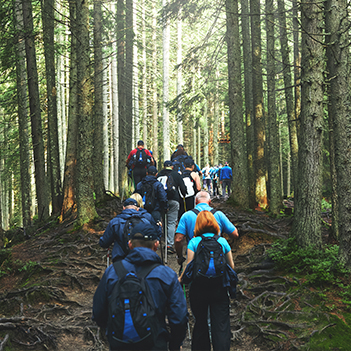Whittle le Wood; Tues 6 Dec. 16
The Pictures;-
To see who was on the walk, click on the following picture:-
To view all the pictures taken on the walk click 'HERE' then on the first picture to view in full screen. To continue click arrow on right.
The Walk:-
Walk leader - Brian Siddle.
Distance - A little over 13 miles.
Weather - Dry all day. Overcast with just a light breeze. As a result of two weeks of fine weather, the going underfoot was much drier than expected.
Number on walk - 18 and 1 dog.
The first stage of the walk took us along the A6, up Town Lane, along the towpath of the Leeds/Liverpool Canal to Botany Bay, along Bagganley Lane and then up through fields and woodland to our morning coffee break on Healey Nab. Unfortunately the overcast condition took away the otherwise open views we normally expect from here.
Leaving the Nab, we dropped down through woodland then through fields to Higher Healey, along Higher House Lane for a short stretch before more field paths took us to White Coppice:-
Quote White Coppice is a pretty hamlet situated at the foot of the West Pennine Moors, and consists of stone cottages, which were originally built for workers in the weaving mill, which has now been demolished. The 18th century cottages known as 'The Row' are good examples of the period. The mill was powered by a water wheel fed by a reservoir, which can still be seen adjacent to the cricket field. Alfred Eccles, the mill owner, devoted much of his life to the Temperance movement refusing to allow a licensed establishment in the area and even today this still applies. Farming and quarrying were alternative sources of employment and the hamlet had its own school, owned by St Barnabas church at Heapey. The school is now a private residence. White Coppice is also the birthplace of Henry Tate in 1819 who funded the Tate Gallery on the banks of the Thames . He made his fortune by discovering the method of turning loaf sugar into cubes.
From White Coppice we followed the Goit, then made our way up through Brinscall Woods, before dropping down to Brinscall, where we had our lunchbreak at the picnic area adjacent to the lake. The end of the second stage.
The final stage of our walk took us out of Brinscall along the line of the old railway track as far as Withnell, then up the hill to the memorial to Private James Miller whose heroic deed won him the Victoria Cross in WW1. (To read about his heroism click on the following link:- http://www.victoriacrossonline.co.uk/james-miller-vc/4587645056 . Continuing on our way we next we took the path over Pike Lowe, crossing the private air strip before descending via Higher Snape to Withnell Fold. Here we crossed over the Canal, then through fields to Marsh Lane, which we followed for a short way, before more field paths and a farm lane took us up to the site of the old Brindle Workhouse (see below) and cottages at Top o' th' Lane.
Quote 300 years ago, workhouses were a popular form of relief for the poor. They became a standard form of relief during the 18th century and were soon favoured by parishes as an alternative to providing direct aid to surrounding inhabitants such as food and fuel. This was intended to deter paupers from seeking aid, and workhouse conditions were purposely at subsistence level. Conditions could be bearable in some houses, but more often than not they were designed to discourage paupers.Brindle workhouse was originally set up by the parish, using a small, converted, catholic ‘mass house’ which had been used to hold illegal masses up until 1701. Later legislation allowed parishes to defer other forms of aid and offer only the workhouse. The Brindle parish decided to convert the building into a workhouse and lunatic asylum. By 1745, the overseers had built a large, roughcast construction to house the poor from at least 15 other parishes for a fee.The number of paupers in the workhouse continued to expand until the early 1800’s when around 80 townships were recorded as sending their poor there. Brindle Workhouse soon gained a national reputation for taking cases than no one else would, and in 1760 was one of the few large workhouses in Lancashire with over 60 paupers. The 1825 Baines Lancashire Directory referred to it as ‘a general receptacle for pauper lunatics and the idle and refractory poor’. Conditions improved after the house was absorbed into the official Poor Law Union System, but Brindle workhouse still made the national press. At least twice in the late 1850s and ’60s, there were sensationalized accounts of brutal deaths that resulted in prison sentences for workhouse staff. Newspaper articles of the time refer to an inmate ‘being restrained by leg locks’ whilst another was beaten to death by a warden. At its peak, the workhouse housed between 200 and 300 paupers in harsh conditions. In 1826, Jourden Hindle, local Justice of the Peace, thought the conditions so dire that he requested the closure of the workhouse. Eventually the workhouse closed over the Christmas break at the end of 1871, with the paupers being transferred to the new workhouse at Eaves Lane in Chorley.
Having absorbed all that, you may wish to know we then continued on our way from there, going first over Denham Hill and it's associated old quarry before crossing the M61 and down Hill Top Lane past the Whittle Tunnels and along Cawood Lane (now just a footpath) and back to our cars in Whittle le Woods.
Thanks Brian for leading an interesting walk through an area many of us know well. You did very well fending off the rain over the couple of weeks prior to the walk resulting in the generally good conditions underfoot, but a clearer day for us to take in the views from Healey Nab and Denham Hill would have been preferable. Thanks again.
Stan.







